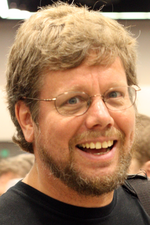Python
Python is dynamically-typed and garbage-collected. It supports multiple programming paradigms, including structured (particularly, procedural), object-oriented and functional programming. Python is often described as a "batteries included" language due to its comprehensive standard library.
Guido van Rossum began working on Python in the late 1980s, as a successor to the ABC programming language, and first released it in 1991 as Python 0.9.0. Python 2.0 was released in 2000 and introduced new features, such as list comprehensions and a garbage collection system using reference counting. Python 3.0 was released in 2008 and was a major revision of the language that is not completely backward-compatible and much Python 2 code does not run unmodified on Python 3. Python 2 was discontinued with version 2.7.18 in 2020.
Python consistently ranks as one of the most popular programming languages
History
Python was conceived in the late 1980s by Guido van Rossum at Centrum Wiskunde & Informatica (CWI) in the Netherlands as a successor to ABC programming language, which was inspired by SETL, capable of exception handling and interfacing with the Amoeba operating system. Its implementation began in December 1989. Van Rossum shouldered sole responsibility for the project, as the lead developer, until 12 July 2018, when he announced his "permanent vacation" from his responsibilities as Python's Benevolent Dictator For Life, a title the Python community bestowed upon him to reflect his long-term commitment as the project's chief decision-maker. In January 2019, active Python core developers elected a 5-member "Steering Council" to lead the project. As of 2021, the current members of this council are Barry Warsaw, Brett Cannon, Carol Willing, Thomas Wouters, and Pablo Galindo Salgado.
Python 2.0 was released on 16 October 2000, with many major new features, including a cycle-detecting garbage collector and support for Unicode.
Python 3.0 was released on 3 December 2008. It was a major revision of the language that is not completely backward-compatible. Many of its major features were backported to Python 2.6.x and 2.7.x version series. Releases of Python 3 include the 2to3 utility, which automates (at least partially) the translation of Python 2 code to Python 3.
Python 2.7's end-of-life date was initially set at 2015 then postponed to 2020 out of concern that a large body of existing code could not easily be forward-ported to Python 3. No more security patches or other improvements will be released for it. With Python 2's end-of-life, only Python 3.6.x and later are supported.
Python 3.9.2 and 3.8.8 were expedited as all versions of Python (including 2.7) had security issues, leading to possible remote code execution and web cache poisoning.
- Versatile, easy to use and fast to develop. ...
- Open source with a vibrant community. ...
- Has all the libraries you can imagine. ...
- Great for prototypes - You can do more with less code. ...
- Speed limitations. ...
- Problems with threading. ...
- Not native to mobile environment
- Easy to Read, Learn and Write. Python is a high-level programming language that has English-like syntax. ...
- Improved Productivity. Python is a very productive language. ...
- Interpreted Language. ...
- Dynamically Typed. ...
- Free and Open-Source. ...
- Vast Libraries Support. ...
- Portability.
- Python's memory consumption and garbage collection. Python's memory usage is high. ...
- Python's dynamically typed. Many in data science and machine learning prefer statically typed languages. ...
- Multithreading in Python is not really multithreading. ...
- Python in functional programming


